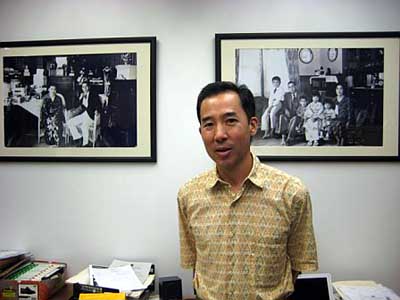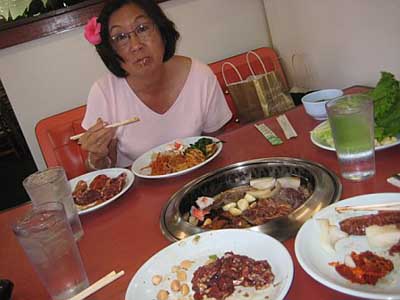14 Oct Hawaiian Eye – Pt. 8 (Researching the past)
 We didn’t see many geckoes during our visit, but here’s one tiny one we saw next to a sculpture of a gecko, outside Richela’s front door. We didn’t see many geckoes during our visit, but here’s one tiny one we saw next to a sculpture of a gecko, outside Richela’s front door. |
Friday, Sept. 21
Another big food day. We’re eating our way across Oahu.
It was also a day of hunting history.
We began the day with Richela, who joined us in a drive downtown to the Japanese Cultural Center of Hawai’i.
It’s a very nice facility in a nice building, with a museum, gift shop and research library dedicated to the history of Japanese Americans in Hawaii.
It turns out that the director of the JCCH’s Resource Center, who operates a research library, archives and a staff of volunteers is Brian Niiya, an author and respected JA historian, who I’ve e-mailed in the past. We even ran into each other once at the Japanese American National Museum in Los Angeles.
He’s the editor of, among other books, the very comprehensive “Encyclopedia of Japanese American History,” which was published by JANM.
 Brian Niiya, director of the Japanese Cultural Center of Hawai’i, in his office, which is decorated with photos of his grandfather and his family. His grandfather ran a newspaper in Hawaii, and like my grandfather, returned to Japan before WWII. Brian Niiya, director of the Japanese Cultural Center of Hawai’i, in his office, which is decorated with photos of his grandfather and his family. His grandfather ran a newspaper in Hawaii, and like my grandfather, returned to Japan before WWII. |
At the JCCH, Niiya is heading up a project researching and educating the public about an internment camp for Jas in Hawaii during WWII. This came as something of a surprise for us mainlanders (and apparently many Hawaiians as well) because we had been under the impression that after a small number of community leaders had been sent to mainland camps, Hawaiian JAs had not been interned in camps on the Island. This is a pretty intense project; I’m looking forward to its opening.
Niiya and his helpful staff introduced us to the books and materials on hand at the Resource Center, although there was nothing immediately to learn about my dad’s family. Brian later sent me an e-mail, informing me that a Japanese-speaking JCCH volunteer had found my grandfather’s construction company, and its address (just around the block from the home address that Aileen had taken us by!) in a 1930s Japanese directory.
I’ll definitely stay in touch with Brian, and plan to spend a lot more time at the JCCH on our next visit to Honolulu.
With time running short, we left Brian and the Resource Center and explored the JCCH’s gift shop and exhibit spaces. The current exhibit, appropriate for Halloween, was “Obake Odyssey” (“obake” is Japanese for ghost) with storytelling, movie posters of Japanese ghost stories, and historical artifacts having to do with death, demons and ghosts – a big part of both Japanese and Hawaiian cultural legends. The permanent exhibit is a timeline of Japanese immigration to Hawaii… we half expected to see the portrait of my dad and his family on the wall as part of the display.
Afterwards we walked down the street to an all-you-can-eat Korean BBQ, Yakiniku Camellia. It was wonderful, although a bit over the top, so have as much calbi and bulgogi as we could stand, and also keep going back for more dumplings and kimchee and other sides.
 All-we-could-eat Korean BBQ — our idea of heaven! All-we-could-eat Korean BBQ — our idea of heaven! |
Richela headed off on her own after lunch, and Erin and I drove to the main branch of the Public Library, which is on the grounds of the old pre-territorial palace, right in the middle of downtown. We wanted to see if we could find any news articles about my grandfather and his family, or find a death notice for my grandmother.
It didn’t long to realize that the microfilm we were scrolling through in the library’s basement, for the Honolulu Advertiser and the Honolulu Star-Bulletin newspapers, were mostly a history of the haole, or white, community on Hawaii. There were some stories about the native Hawaiians and some mentions of Asians in the news. But the vast majority of the news in the papers were about Caucasians, or people with Anglo-European surnames.
Luckily, Erin happened to notice a memo on the wall about marriage and death certificate archives, so we asked about those and were sent to the main floor to the section for research on Hawaii. There we were shown drawers with film of state records, and after some searching, we found my grandmother’s death notice: Tomeno Asakawa had died on June 20, 1940.
This jibed with known accounts of her death, literally on the night before my grandfather was to take the family to Japan. They left a month later, in July, 1940.
We couldn’t glean any more information – no coroner’s report or cause of death was noted on this very small, insignificant library index card saved on microfilm for posterity. For that information, we’d have to go to the state health department, where we’d been a couple of days before, and have a blood relative born or married in Hawaii make the request.
We stayed a little longer and tried to find a marriage date for my grandparents, but couldn’t, even though we looked in the records from 1910-1921 (we had decided that if Aunt Miki, my oldest Aunt, had been 18 in 1940, my grandparents probably got married sometime between 1918-1920).
We had to leave the library for an appointment – believe it or not – with a psychic. Richela had asked her mother for a recommendation and we had called Rev. Hal Beagle, a psychic minister who worked out of his Honolulu apartment. It took us a while to find parking around his apartment, but we finally made it.
The reading itself turned out to be something of a bust, unfortunately. Much of what he said about my grandmother seemed to miss the mark, even though he knew my grandmother had died in 1940, and possibly under suspicious circumstances. When I prompted him and asked what kind of vision he had on the words “turtle soup,” he grasped my hands a little tighter, squeezed his eyes shut a little harder and said, “Your grandmother was a gourmet, and she loved turtle soup.”
True enough, we thought.
“She also loved to go to restaurants and try their specialties and figure out how to make them at home.” I almost burst out laughing at this one. I doubted seriously that my grandmother would have gone out to restaurants in the 1930s with eight kids and a husband to feed, and then try to replicate the gourmet dishes at home.
I have a cassette of the session, which I’ll listen to again. He said that some of the things he mentioned might not make any sense at first but would become more clear later.
Erin and I went back to Richela’s home a little bit deflated but still determined to find out more about my family history.
Once home, we got a call from cousin Aileen, who invited us to dinner again. Richela stayed home, and Erin and I were picked up and taken to Kai, a hip izakaya like Momomo the previous night.
But Momomo didn’t serve okomiyaki, a Japanese version of an omelet and pancake that’s often served at izakaya. So Aileen decided to take us to Kai, which served an excellent okonomiyaki, as well as other delicious a la carte items, including an incredible grilled lotus root served with melted cheese.
On the way back to the Hawaii Kai area, Aileen pulled over by a beach and gave us a taste of “The Light,” which sounds very religious in a strict, Christian sense, but isn’t. It’s a spiritual pursuit that she studied for years, which seems to use energy transference to help people. So now it sounds woo-woo and new-agey, but it’s not quite that either.
It was 10 minutes each with us closing our eyes and Aileen holder her hand in front of our heads. I felt relaxed, safe and curious, but didn’t feel any big changes. I was, however, more confident and felt more powerful at work upon my return. At least, for a couple of days, anyway!
“The Light” was a transcendent way to end out next-to-our-last day in Honolulu.



